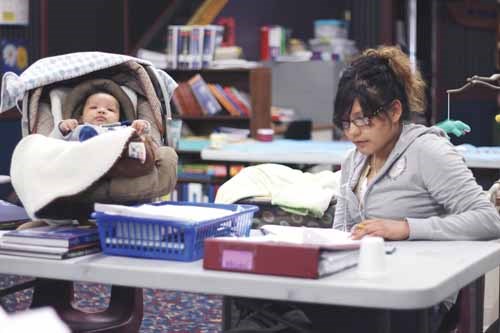No matter the lengths gone to by teachers and social workers, there are always kids who don't meet the expectations of a standard school.
"I don't do so well with the rules," admits Matthew, who left both Yorkton Regional and Sacred Heart High Schools. "I'm a pretty angry guy."
For the better part of a decade, Dreambuilders Alternative Learning Centre-a partnership between Christ the Teacher School Division and various other organizations-has been accepting the students who don't fit in anywhere else: kids with serious behavioral or motivational problems, some of them freshly released from the justice system.
"All these kids are here for a reason," says Kelly Maddin, principal of the school located at SIGN on Broadway. "That's not to say they're dysfunctional, but sometimes some concessions need to be made."
Those concessions vary with each day and each student. Everyone who attends the school is given a learning plan tailored to their needs. Some might only be able to attend three days a week. Some need to work through personal issues with Maddin or the school's social worker in the morning before they're ready to learn.
Megan, a 14-year-old mother of two, is able to attend school because of Dreambuilder's flexible policies. She brings her infant to class with her each day.
Maddin calls Megan an exceptionally bright girl, but she had trouble adapting to the mainstream school system when she arrived in Yorkton last October to stay at an adolescent group home.
"I wasn't familiar with Yorkton and I had nobody here. Then I came here and all the sudden I had some friends," she says. "I love school. It's really helping me lots, keeping me busy. It's a good school."
Disciplinary issues at Dreambuilders are handled immediately as in any other school, but the kids are given far more chances than they would be elsewhere.
"Some of the youth that come in here, they can be pretty disrespectful. They can be pretty angry about their lives, about themselves," Maddin says. "We have to forget about those things, and every day's a new day. Because the next day the kid comes in, maybe he's ready to work."
A selectively short memory is essential. Maddin is keenly aware that if youths fall through the cracks of Dreambuilders, no one is likely to catch them.
"If a kid is unsuccessful at an alternate school in Saskatoon, there are still lower layers or other options for them. In Yorkton, we are the only option."
While the content of the Dreambuilders curriculum is similar to other schools, the format differs. Set up in the open space of a former bar, the facility resembles an old one-room school.
"That's exactly what we are," Maddin says. "It's still Saskatchewan curriculum, it's still accredited classes. It's just a smaller environment with a better teacher-to-student ratio, and we let the kids work at their own pace."
The school employs 3.8 full-time teachers, two of them typically overseeing the Grade 7-9 students and two the Grade 10-12s. With classes usually not exceeding 10 students, the arrangement allows enough individualized instruction for each student to learn at his or her level. A continuous intake school, Dreambuilders accepts enrollments at any time of the year, and students are tested only when they are ready.
Attendees of the school might take two years to earn a grade level, but they will earn it. Still, says Maddin, the school likes nothing better than to see its students transitioned back into the mainstream education system.
That's one of the reasons Dreambuilders buses students to Sacred Heart High School for a few hours each week to participate in regular classes on subjects not available at the smaller facility: welding or cosmetology, for example.
"Maybe a kid will go over there and take one class and it'll stick, and the kid will want to go there next semester," Maddin says. "That's a success for us."
Some students have no interest in further academics, at least for the immediate future. For these, Dreambuilders offers the Transition to Work Program, which aims to make its clients employment-ready.
Like the academic program, students here proceed at their own pace, but they study a curriculum covering knowledge such as budgeting, resumé writing, interview skills, labor laws, and employer expectations. Once their basic skills are in place, the program helps its clients attain certification in fields such as first aid, CPR, and safe food handling. Instructors also take the students to career fairs, on resumé drop-offs, and on tours of workplaces and post-secondary institutions.
Dreambuilders maintains contact with a bank of local employers and matches students up with subsidized work placements.
Sometimes, these can be the beginning of a career. Matthew, 21, entered the Dreambuilders academic program four years ago. He struggled to find a job before receiving a work placement in the construction industry through the Transition to Work Program. He now has more than 1,000 hours of work supervised by a tradesperson behind him, and is working towards his Grade 10 diploma to continue on the path of becoming a journeyman carpenter.
Matthew is grateful for what Dreambuilders has provided him.
"It's awesome. It's better than regular high school."
Other graduates of the work program, says Work Transition Coordinator Charles Bellegarde, are now completing university or operating their own companies.
But to benefit from the programs, students must first make their way to the school. Dreambuilders accepts both referred and volunteer students; Maddin and Bellegarde urge any youths under the age of 21 who are not attending school or people who know such youths to give Dreambuilders a call.
Maddin praises his staff, but notes it is ultimately up to the kids to achieve success.
"I give these kids a lot of credit for walking through this door. They probably had the option to sit and play Xbox or PS3 at their friend's house, but they decided to come here to school."




